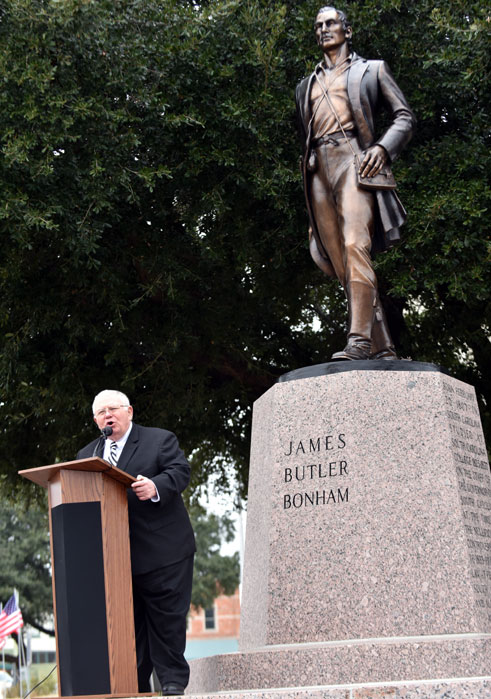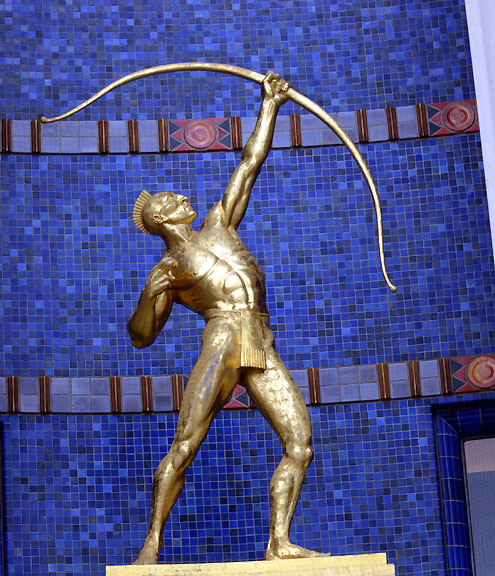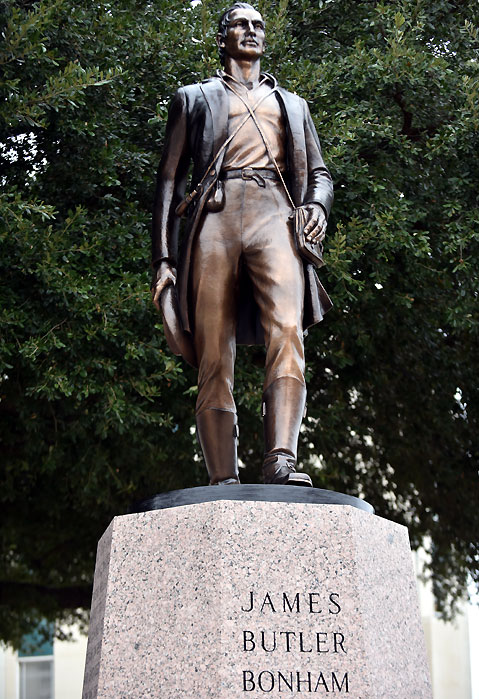Bonham, Texas -- On May 12, 2009, Gov. Rick Perry appointed Dr. Light Cummins to be the Texas State Historian for a period of two years, but that was only one title that has been bestowed upon the Guy M. Bryan Professor of American History at Austin College. Cummins has been a Fulbright Scholar to Spain, a U.S. Air Force intelligence officer during the Vietnam era, an Associate of the Danforth Foundation, a former member of the Board of Directors of the Louisiana Historical Association, a former chair of the Grayson County Historical Commission, he served two terms as a member of the Board of Directors of the Texas Council for the Humanities, and Cummins is a lifetime Fellow of the Texas State Historical Association.
King Juan Carlos I of Spain awarded Cummins the Premio de Espaņa y America in 1994 for the gifted historian's detailed research regarding the shared history of the United States and Spain.
Cummins also bears the honorary title of Kentucky Colonel, an award given by Kentucky Gov. John Y. Brown, Jr. for Cummins's documentation of the history of the Mississippi Valley.
It was the subject of his ninth book that brought the esteemed historian to Bonham for a lecture several years ago.
It is doubtful that anyone knows more than Cummins about the historic statue of James Butler Bonham that graces the southeast corner of the Fannin County Courthouse square in downtown Bonham, or Allie Tennant, the internationally known Dallas sculptor who created this homage in bronze to a fallen hero of the Alamo. Cummins even wrote a biography of Allie Victoria Tennant, a Dallas sculptor who lived from 1892 to 1971.
"She is best known today in Fannin County as the sculptor of the 1938 statue of James Butler Bonham on the courthouse grounds of the city which bears his name. Miss Tennant enjoyed an international reputation during her lifetime, especially from the 1930s to the 1970s, as a preeminent American sculptor, particularly in portrait sculpture and heroic statuary. Today, her works can be found all across Texas and in art museums."

Dr. Cummins told how, even as a young child growing up in St. Louis, Allie displayed an affinity for art, and in particular she enjoyed working with modeling clay.
Cummins even managed to find Tennant's recollection of her first artistic endeavors.
"I always loved to make mud pies," she recalled as an adult, "as I loved the feel of the earth."
Eight-year-old Allie took a lump of mud from the family garden and fashioned it into a bust of George Washington that, to their astonishment, the entire family recognized.
Unfortunately, the young artist would soon learn a hard lesson. The bust of Washington was placed on an outside windowsill to dry; however, an overnight rain reduced Allie's hard work to the lump of mud from which it came.
"The eight-year-old artist decided from that point on she would work only in stone and bronze," Cummins said with a smile.
"I was heartbroken," Tennant would later say. "I thought a work of art had been destroyed."
Because Allie's father was experienced in the coal business, Texas and Pacific coal mines lured Thomas R. Tennant to the rough and tumble little company town of Thurber, Texas to manage the mines. The Tennant family, however, chose to settle in Dallas, 100 miles to the east of Thurber. By the time Allie graduated from Dallas High School in 1911, her life revolved around the study of the arts and she set her sights on a career as a professional artist. She began taking classes in a private art school in Dallas operated by Vivian Anspaugh. Dr. Cummins's research indicates this was one of the first such art education institutions in the Southwest.
As Allie delved deeper into the Dallas art scene, friendships began to develop with a number of artists and art aficionados in the area. As someone who had a keen interest in social events, Allie enjoyed the company of Jerry Bywaters, Reveau Bassett, E.G. Eisenlohr, Frank Klepper, Frank Reaugh, Otis Dozier, William Lester, Buck Winn, Lloyd Goff, Everett Spruce and Charles T. Bowling.
The late 1920s found Allie in New York City where she was under the tutelage of renowned sculptor Edward McCartan at the Art Students League. By the time Allie returned to Dallas in the early 1930s, she had already developed a reputation as one of the best-known sculptors in the Southwest. She would live up to that reputation. Allie would soon be exhibiting work at the Pennsylvania Academy of Fine Arts (1935), the Art Institute of Chicago (1935), the Kansas City Art Institute (1935), the Architectural League of New York (1938), the World's Fair in New York (1939), the Whitney Museum of American Art (1940), the National Sculpture Society (1940), and the Carnegie Institute (1941).
In 1936, Allie sculpted what would be her most famous work as well as one of the most famous statues in Texas, the "Tejas Warrior" that towers above the entrance to the majestic Hall of State located at Fair Park in Dallas.

The Hall of State was designed to be the centerpiece of the Texas Centennial Celebration, and Dr. Cummins discovered it was an infusion of money into the arts in association with the Texas Centennial that afforded Allie Tennant an opportunity to sculpt two other heroic statues that would ensure her reputation: one was the statue of Jose Antonio Navarro in Corsicana and the other, James Butler Bonham here in the city of Bonham. Other statues sculpted under this program included Stephen F. Austin at San Felipe, Sidney Sherman (Galveston); Richard Ellis (Waxahachie); James Pinckney Henderson (St. Augustine); R.E.B. Baylor (Waco); Ben Milam (two statues, one in Cameron and one in San Antonio); Anson Jones (Anson); Mirabeau B. Lamar (Richmond); Henry Smith (Brazoria); James Bowie (Texarkana); Thomas J. Rusk (Henderson); Peter H. Bell (Belton); Richard Dowling (Sabine Pass); George G. Childress (Washington-on-the-Brazos); David G. Burnett (Clarksville); Moses Austin (San Antonio); and John O. Meusebach (Fredricksburg).
After doing exhaustive research on Navarro and Bonham, Allie Tennant began to sculpt the statues of both men simultaneously at her Live Oak Avenue Studio in Dallas. The statue of Navarro had the distinction of being in honor of one of the few Hispanic Texans recognized during the Texas Centennial Celebration. That statue was dedicated in the fall of 1938 and dignitaries that gathered in Corsicana included U.S. Senator Tom Connelly, Congressman Luther Johnson and Beaufort Jester, a native of Corsicana who would later be the governor of Texas.
Once the city of Bonham was selected as the site for the statue of James Butler Bonham, a minor controversy developed because Miss Tennant envisioned a statue of Bonham wearing buckskin, while Bonhamites asked for the town hero to be clothed more formally. Adamant townsfolk seemed to have a slight edge in this debate, when Cummins found that University of Texas historian Amelia Williams proclaimed that James Butler Bonham had only been in Texas for a few months before dying in the Alamo and had never been a frontiersman.
Dr. Cummins found where Williams had addressed the controversy in a Dallas Morning News article.
"By no means picture Bonham in buckskins," Williams was quoted as saying in the Dallas Morning News, "for it is very unlikely that he ever wore them."
Allie Tennant would go on to dress James Butler Bonham according to the wishes of Bonhamites, although the artist felt obliged to put a powder horn over the formal attire and added a very prominent set of spurs over Bonham's brogan boots. Perhaps neither was historically correct, but fell more under the realm of artistic license.
Once the clay model was finished in Dallas, it was cast in plaster and shipped to New York where the firm of E. Gargoni and Sons, one of the preeminent foundries in the nation, made molds for the bronze casting.

Dr. Cummins observes that in technical point of fact, Tennant's statue of James Butler Bonham was born at Eugene G. Gargoni and Sons Art Foundry located at 467 142nd Street in the Bronx section of New York City.
The bronze statue made it back to Bonham in December 1938. A pedestal made from the same pink granite as the capitol building was prepared in the Rodriguez Brothers workshop in San Antonio and shipped to Bonham where, on December 10, 1938, Allie Tennant personally supervised the placement of the statue on the pink marble base.
Amazingly enough, Dr. Cummins notes that the cost of the artwork, carving, bronzing, marble cutting and shipping was $7,500.
H.A. Cunningham served as master of ceremonies on December 18, 1938 at the dedication of the statue. Fannin County Judge J.E. Spies speech had people on their feet when he exclaimed, "Remember the Alamo and Remember Goliad."
The President of the James Butler Bonham chapter of the Daughters of the American Revolution gave an account of the Texas patriot's ancestor's lives. Congressman Sam Rayburn was the keynote speaker and expressed his appreciation for this remarkable statue. And James Butler Bonham's grand-niece, Mrs. Edgar Wade of Dallas, pulled the cord to unveil the statue. Ceremonies concluded when the Bonham children's choir sang, "Texas, Our Texas."
Allie Tennant was in great demand throughout the 1940 and into the 1950. She remained very active in the Dallas arts community by serving several terms on the Board of Directors of the Dallas Museum of Fine Arts. In 1971 when Allie Tennant died, she had carved out her rightful place in the history of Texas art.
Residents of Bonham will forever be indebted to the creative genius that was Allie Tennant. And art aficionados everywhere are certainly appreciative of the time, expertise and effort put in by Dr. Cummins to uncover the facts behind this fascinating artist.
photos by Allen Rich